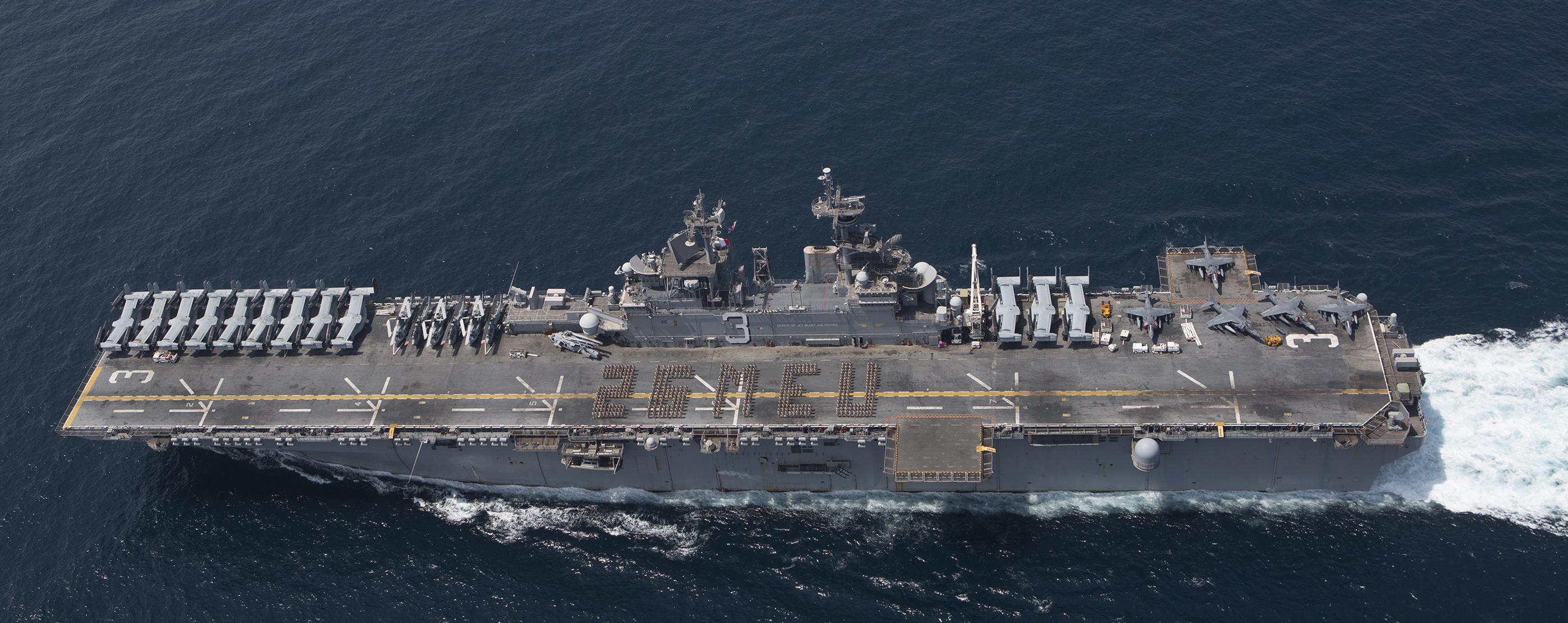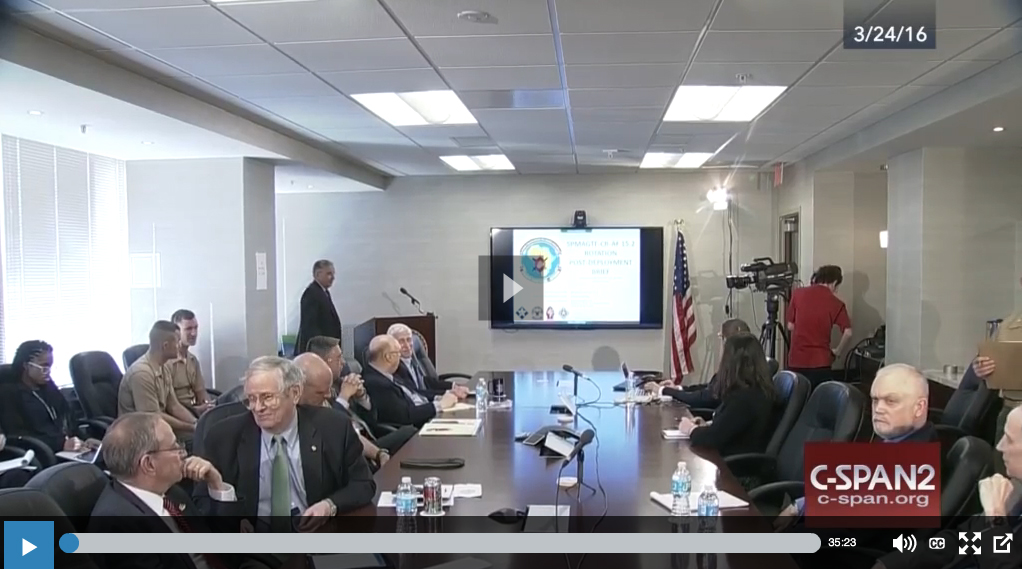Divisions
U.S. Marines and Sailors assigned to the 26th Marine Expeditionary Unit (MEU) spell out 26 MEU on the flight deck of the amphibious assault ship USS Kearsarge (LHD 3), Mar.14, 2016 in the Arabian Sea. http://www.26thmeu.marines.mil/Photos.aspx?igphoto=2001552228
30th June 2016 - As part of its Returning Commander Speaker Series, the Center for Adaptation and Innovation hosted Colonel Robert Fulford of the 26th Marine Expeditionary Unit (MEU), and Captain Augustus Bennett of the Kearsarge Amphibious Ready Group (KSG ARG), on 30 June 2016. The MEU/ARG were deployed from 6 October 2015 to 3 May 2016. The KSG ARG deployment encompassed 210 days; 181 days operating in split configuration and 8 as disaggregated days. The MEU deployment encompassed 242 days, of which 59 were disaggregated days.
The Marine Expeditionary Unit (MEU) / Amphibious Ready Group (ARG) is a flexible Marine Air-Ground Task Force (MAGTF) that performs a Range Of Military Operations (ROMO) with a focus on amphibious operations and expeditionary support, backing Geographic Combatant Commanders and providing crisis response. This MEU/ARG took part in 4 named operations, 4 theater security cooperation exercises, 1 bilateral exercise, and 11 exchanges with Special Operations Forces throughout the CENTCOM, EUCOM, and AFRICOM theaters. Of these exercises, two major exercises were conducted with 6th fleet, and the bilateral training exercise with Turkey exercised the full capability of the landing force by conducting ship to shore operations.
Colonel Fulford and Captain Bennett emphasized the value of their rigorous and aggregated Pre-Deployment Training Program (PTP) in mission preparation and creating a unified team. Their training and well-monitored supply chain ensured that they were prepared for every mission. Colonel Fulford and Captain Bennett also affirmed their decision to request and receive specialists to help with intelligence collection and analysis. Interoperability was also key to a joint understanding of requirements and limitations. The Marine Corps and the Navy exchanged liaisons, thereby improving naval integration. Web-based communication was also important for connectivity, and will continue to be in the future.
The value of blue-green teaming and the resulting amphibious capabilities stems from the increased flexibility, adaptability, and agility derived from such a force. There will be more split operations in the future, due to the increasing number of requirements and decreasing number of ships. These split operations are most successful when conducted by a well-integrated team. Today’s threat environment requires an agile response from amphibious units, and cooperation and coordination between our naval assets to promote warfighting readiness.
We would like to acknowledge the loss of Staff Sergeant Cardin who died from wounds suffered following an indirect fire attack at Fire Base Bell in northern Iraq.
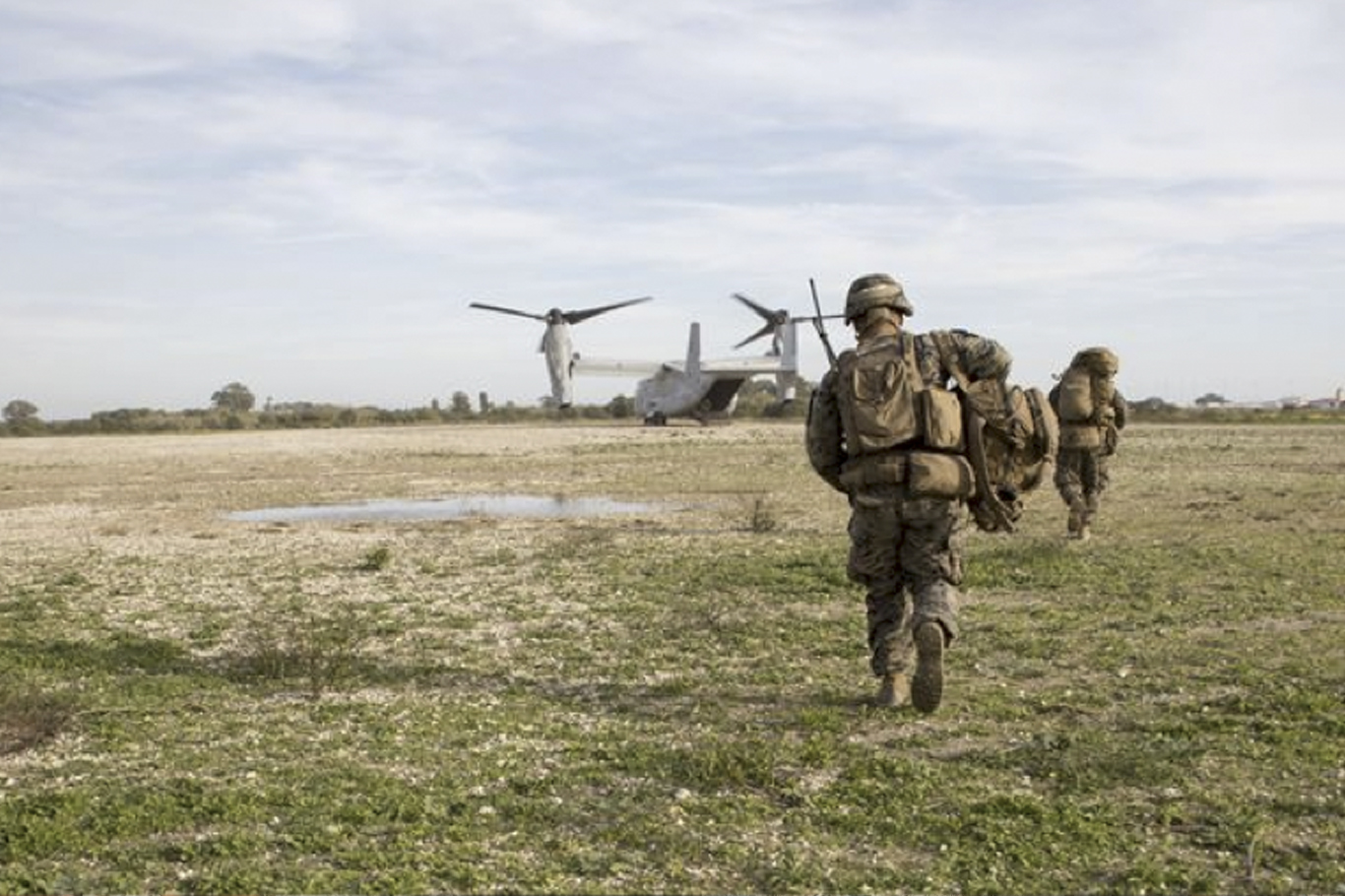
On 16 December 2016 the Center for Adaptation and Innovation (CAI) hosted the Special Purpose Marine Air Ground Task Force – Crisis Response – Africa (SPMAGTF – CR – AF) Rotation 16.1, as part of its Returning Commander Speaker Series. A rotational force of Marines and sailors, the SPMAGTF – CR – AF is capable of decisive action across a range of military operations, and was established in 2013 in response to the attack on American diplomats in Benghazi, Libya. The SPMAGTF-CR-AF provides U.S. Africa Command and U.S. Marine Corps Forces Africa a broad range of military capabilities to respond to crises in its area – of – responsibility (AOR), which includes conducting noncombatant evacuation, humanitarian assistance, disaster relief and support to U.S. embassies, amongst other missions, operations and activities.
Speaker and Commanding Officer, Colonel Martin “Marty” Wetterauer III, described their mission as conducting limited crisis response and contingency operations in conjunction with Theater Security Cooperation (TSC) activities in order to protect U.S. citizens and strengthen U.S. interest in the USAFRICOM area of operation. Temporarily positioned on Morón Air Base, Spain, the SPMAGTF – CR – AF conducted 26 Theater Security Cooperation Engagements in 10 African countries, over 120 training events throughout USAFRICOM and USEUCOM AORs, and conducted Cooperative Security Location validations in all three Gulf of Guinea locations.
Throughout their deployment, the SPMAGTF-CR – AF worked alongside Special Operation Force (SOF) partners to provide real world mission support and training and planning integration, including high threat/ high risk diplomatic post surveys and crisis response working group meetings. According to Col Wetterauer, “they will be tightly integrated with SOF partners, at least until Libya becomes a stable environment and SOF are not the only one’s securing the environment.” This will be their primary task.
With the ability to quickly integrate and deploy, the MAGTF is often first to be called upon in times of crisis, even when there are other options available. Col Wetterauer indicated that due to other options available, CR – AF may not always be the most appropriate response, and who to call on is an ongoing education process with the State Department and African countries.
The MAGTF is working with half the Osprey’s they were last year in order to boost stateside readiness, going from 12 down to 6. Col Wetterauer assured that their mission only calls for 6, assuming 2 are down, 2 are conducting missions, and 2 are the back up to conduct logistics, maintenance and training. Col Wetterauer said that aviation readiness is their “number 1 concern.” This echoes the voice of the last RCSS speaker, Col Anthony M. Henderson, commander of the 26th Marine Expeditionary Unit, who reinforced the primacy of Marine Aviation readiness saying that “we have to keep the flight hours going as much as possible, that saves lives.”
Read more about the SPMAGTF – CR – AF brief on DoD Buzz, Seapower Magazine, and on Military.com here and here.
--------
CAI’s Returning Commander Speaker Series offers a forum for naval force concepts and capabilities to be discussed with commanders whom recently completed a deployment. CAI identifies and defines new and potentially disruptive defense capabilities. Specifically, the Potomac Institute for Policy Studies established CAI to assist senior defense leaders grappling with the most demanding issues and problems posed by a complex and uncertain security environment.

Photo by Akeel Adeyemi Austin Courtesy of https://www.facebook.com/SPMAGTFCRCC
The Center for Adaptation and Innovation hosted Colonel William McCollough, USMC, Commander of the Special Purpose Marine Air-Ground Task Force – Crisis Response – Central Command (SPMAGTF-CR-CC), rotation 16.1, on 13 May 2016. The SPMAGTF-CR-CC was deployed from 21 October 2015 to 21 April 2016, and conducted theater security cooperation operations, as well as joint and coalition interoperability training at 11 different sites in 5 different countries. The SPMAGTF-CR-CC was formed in 2012 following the attack in Benghazi, which indicated that there was a need for additional military force capabilities and options to quickly respond to crisis situations.
The SPGMAGTF-CR-CC was formed in 2012, and provides an immediate and relevant crisis response capabilities in support of Central Command (CENTCOM). Composed of 2,300 Marines, sailors, and support elements, the SPMAGTF-CR-CC is a forward-deployed land-based force, that provides rapid response to crisis situations, contingency operations, theater security cooperation, and other missions as directed by the Combatant Commander.
The SPMAGFT-CC-CR must be ready to respond at all times, and to operate on commander’s intent. Therefore, the force constantly trains, reevaluates, regroups, and retests. By doing so, the force maintains its operational readiness and response capabilities. Key operations and exercises conducted by the SPMAGTF-CC-CR included: strike operations against ISIS, support for Task Forces Al Asad (TFAA) and Al Taqaddum (TFTQ), as well as critical coordination with logistics combat element, the Air Combat Element, and various maintenance teams, working together to move over a million pounds of cargo and several thousand troops. The SPMAGTF-CR-CC 16.1 coordinated many different elements over the course of 6 months to build standard operating procedures that can be copied by other MAGTFs in similar deployments. In addition,
Colonel McCollough indicated that the valuable equipment under his control was constantly tested and reevaluated, and was returned in better condition than he received it.
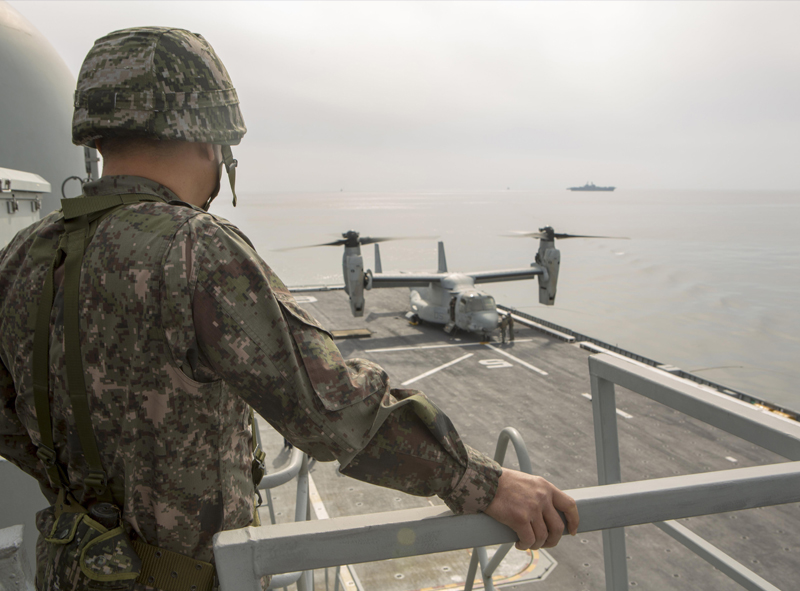
Republic of Korea Marine Corps Lt. Col. Jeong Hyung-Goo watches a U.S. Marine Corps MV-22B Osprey land on the flight deck of the Republic of Korea ship Dokdo (LPH 6111), at sea, March 26, 2015. http://www.31stmeu.marines.mil/Photos.aspx?igphoto=2001045778
7 April 2016 - The Center for Adaptation and Innovation at the Potomac Institute for Policy Studies, as part of its Returning Commander Speaker Series, hosted Colonel Dasmalchi, commander of the 31st Marine Expeditionary Unit (MEU). This MEU was deployed from Fall 2014 to Spring 2016, and took part in multiple exercises throughout the Asia-Pacific region in support of Pacific Command (PACOM) requirements.
The 31st MEU is a forward deployed, Marine Air-Ground Task Force (MAGTF), capable of rapidly executing amphibious operations, designated maritime contingency operations, expeditionary support to other operations, and crisis response, which includes enabling the introduction of follow-on-forces. The 31st MEU is the only continuously forward-deployed MEU, and is the only MEU that maintains a small boat company. This is a unique capability, yet it also a capability tradeoff. While the 31st MEU is the only MEU with a small boat company, its lacks other capabilities such as tanks.
The 31st MEU uses a 6 month “Tight Turn” Deployment Operational Cycle, which starts when the unit deployment battalion teams arrives in mid-May. The 31st MEU is composed of 2,200 Marines and Sailors, of which 68 are permanent personnel in the command element. During its deployment cycle, the 31st MEU executed several amphibious and expeditionary operations to include the following:
• 23- 27 Feb 2015: Executed Theater Security Cooperation (TSC) Event Ivo Sabah in Malaysia. This event was executed with MARFORPAC, and accomplished a combined arms-training operation. A live-fire demonstration was also executed.
• 26 March 2015: The 31st MEU conducted MV-22 Operations aboard a Republic of Korea LPH 61111. This was the first time that an Osprey has landed on a Republic of Korea amphibious assault ship.
• 12-18 July 2015: Exercise Talisman Sabre in Australia was conducted in support of the 3rd Marine Expeditionary Brigade (MEB), and was a partnership exercise to further naval integration with our Australian allies.
• 8-22 Aug 2015: Conducted Saipan DSCA Relief Efforts. The 31st MEU provided distribution support and water production for the lead civil response agency to the Commonwealth of Northern Marianas Island IOT facilitate Typhoon Soudelor (13W) recovery efforts. Hundreds of FEMA supplies and 140 pallets of FEMA food and water were distributed, and a tactical water purification system was used to distribute 366,200 gallons of drinking water.
• 25-29 Oct 2015: Participated in a Naval Infantry/Maritime Security Subject Matter Expert Exchange with 147 Brigade Vietnamese People’s Navy, Naval Infantry IOT set conditions for future III MEF/MARFORPAC Theater Security Cooperation exercises.
Other operations included Presidential Support Missions, Korean Marine Exchange Program 15, TSC Bali, TSC Malaysia, TSC New Zealand, TSX New Caledonia, and Exercise Cobra Gold 15 & 16.
In their next deployment, the 31st MEU will combine a Special Operations Force Liaison Element (SOFLE) element, and in the future when the USS America is sent forward F-35s will deploy with the 31st MEU.
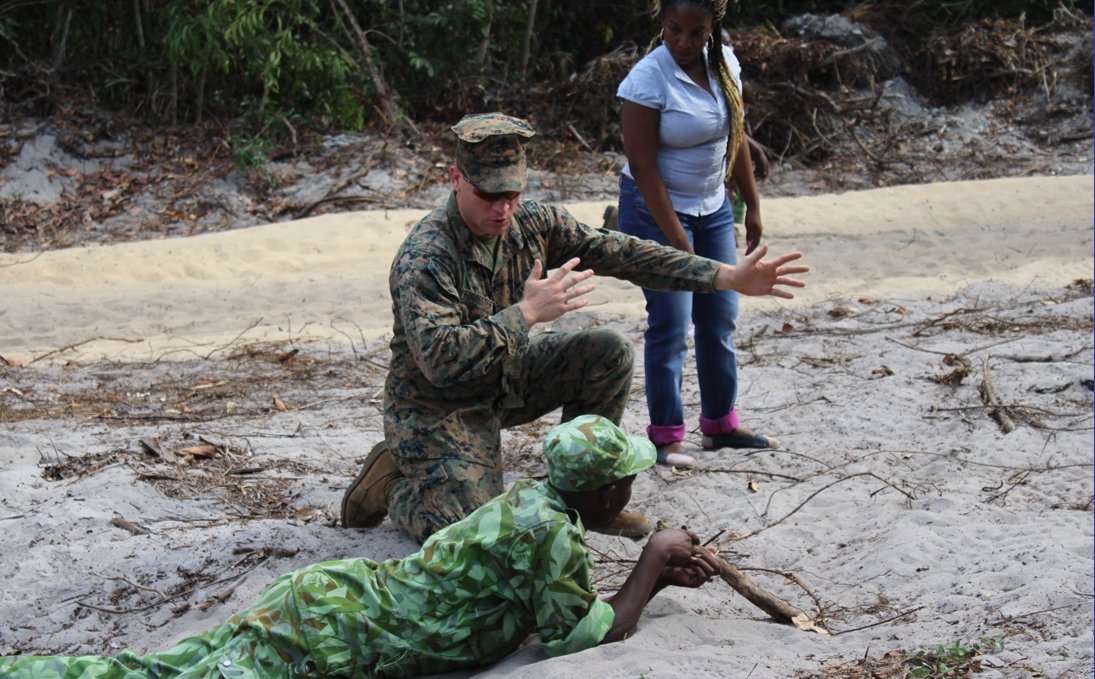
Lance Cpl. Justin Forrester teaches immediate actions drills to a park ranger with the Agence Nationale des Parcs Nationaux (ANPN) at the Pongara National Forest in Pongara, Gabon, Sept. 17. U.S. Marines and park rangers with ANPN, worked together to help the nation’s fight against wildlife trafficking. The Marines trained with the ANPN focusing on infantry tactics to help build the nation’s capacity to counter trafficking of ivory and other animal-related products. (Official U.S. Marine Corps phots by Staff Sgt. Ryan Nikzad) http://www.africom.mil/NewsByCategory/article/26644/u-s-marines-gabonese-share-tactics
On 24 March 2016 the Center for Adaptation and Innovation (CAI) hosted the Special Purpose Marine Air Ground Task Force-Crisis Response- Africa (SPMAGTF-CR-AF) Rotation 15.2, as part of its Returning Commander Speaker Series. The SPMAGTF-CR-AF is based at Morón Air Base in Spain, and returned on 26 January 2016 after a 180 day deployment.
The SPMAGTF-CR-AF responds to a wide range of military operations to provide expeditionary support for crisis response in the Africa Command (AFRICOM)/European Command (EUCOM) regions. The SPMAGTF-CR-AF is a rapid, self-deploying crisis response force, that continues to be relevant in the conduct of military operations across the range of military operations. During its deployment, the SPMAGTF-CR-AF conducted cooperative security location (CSL) validation exercises in Chad, Tunisia, and Libya, site surveys of CSLs, eight major training exercises, and 62 bilateral training exercises with national military forces. Community outreach with Spain and Italy was also conducted, as were the following planning initiatives: Morón Air Base (MAB) Displacement, Allied Maritime Basing Initiative (AMBI), and Ghana Forward Logistics Element (FLE)/Theater Security Cooperation (TSC).
While the SPMAGTF-CR-AF deployment was successful, some operational challenges were encountered. The ability to have a continuity of campaign effort and respond to a crisis “on day one” are both mission requirements, and improvements are constantly being made to enhance mission execution. Going forward, the SPMAGTF-CR-AF is looking to enhance pre-deployment training and integration through the use of the Foreign Service Institute and Mobile Training Teams from the Department of State, integrate Marine Corps training as units prepare for the Embassy Reinforcement and Military Assisted Departure mission(s), promote key relationships with host nations, and maintain security cooperation efforts that are integral to building security and capacity of nation states in the region. Another challenge is logistical support for a continent the size of Africa, and which the SPMAGTF-CR-AF relies heavily on contractors for.
CAI’s Returning Commander Speaker Series offers a forum for naval force concepts and capabilities to be discussed with commanders whom recently completed a deployment. CAI identifies and defines new and potentially disruptive defense capabilities. Specifically, the Potomac Institute established CAI to assist senior defense leaders grappling with the most demanding issues and problem posed by a complex and uncertain security environment.

